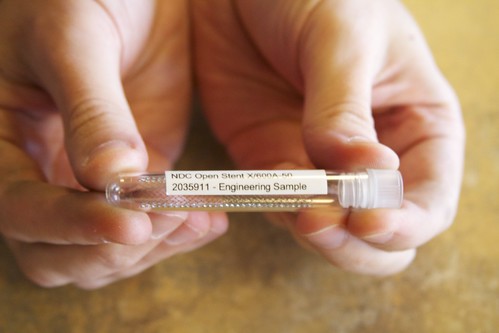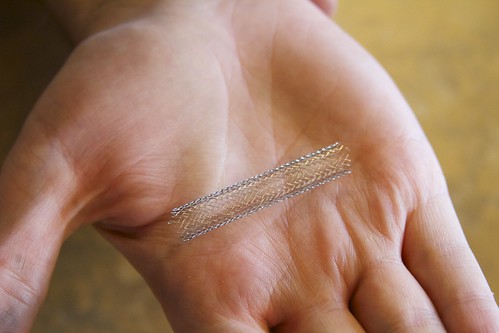

The stent pictured above is an example of an Open Stent from NDC, makers of nitinol materials and devices, particularly for medical applications. In their introduction to the project, they write:
The first problem that we encounter when developing useful and practical educational resources for stent design is that every design we might want to use as an example is proprietary! That leaves us without much to talk about… So to solve this problem, the first step was to create a design to use as an example. The Open Stent is designed to be completely generic, but also realistic, and relatively easy to modify and extend to be useful for whatever purpose a designer intends.
In addition to publishing their draft of Open Stent Design, which they call “a practical guide and resource for design and analysis of a generic Nitinol stent,” NDC has provided extensive calculation tools and CAD files as well, to help others evaluate and create derivatives of the design.
The project is a fascinating open source hardware use case, where creating an open design provides a platform for education and discussion where none existed before. It’s also very exciting to recognize this as an early example of open source hardware in the field of medical devices— one of the places where open hardware can potentially make a very big difference in the world.




As someone who has worked for years in the self expanding stent area I find this very interesting. I know the reason that stent design is so closely protected by big industry players is that finding a balance of durability, flexibility, and deliverability while keeping the compressed size small enough to fit in a reasonable catheter is incredibly complicated. There can be dozens or hundreds of design iterations each requiring up to a million cycles of fatigue and torture testing. If someone offers up a design that can be competitive and makes it open source it would be a real game changer.
The vascular disease market has seen a number of companies come in with low cost alternatives to balloon angioplasty devices but it hasn’t seen the same pressure with implantable devices such as stents for the simple fact that they need to be so robust and the liability and regulatory hurdles are so high.
As a stent user myself, I fi d this highly fascinating.
For a look at another group doing open access medical devices, see the Little Devices Group at MIT